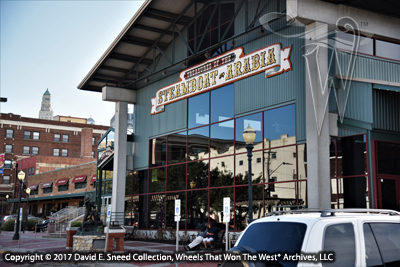There are a number of ways to learn more about America's first transportation industry. Some of the more popular methods include seminars, books, authoritative websites, museums, question-and-answer-sessions, and personal networking. It just so happens that the recent symposium presented by the Santa Fe Trail Association and National Stagecoach & Freight Wagon Association included all of the above.
This is the third and final week of our coverage of the 2017 symposium. As such, we'll focus on a couple more of the event's activities, including our trip to the Steamboat Arabia Museum in Kansas City. The 'night-at-the-museum' included a video, tour, meal, and one-on-one narratives with museum docents. The museum, in two words, is "beyond amazing." This was my third trip and every time I'm amazed at what was found and preserved. There was so much on board this boat that I'm always seeing new things. In fact, the Arabia was packed with over 200 tons of goods when it sank in 1856. As of 2017, the museum is estimating that its till has at least 10 more years of conservation and preservation work to do before all of the recovered items are available for presentation.
 |
| The Steamboat Arabia Museum in Kansas City shares an incredible story that combines mid-1800's history, the lure of treasure hunting, and the power of the American Dream. |
 |
| With numerous scheduled stops on the Missouri River, the Arabia and other nineteenth century steamboats helped provide vital materials to those living on the American frontier. |
 |
| This portion of the Arabia's stern and rudder were salvaged and preserved, helping showcase the vital role America's western steamboats played during the nineteenth and early twentieth centuries. |
 |
Doug Hansen (Hansen Wheel & Wagon Shop) and Jim Patrick take a closer look at an extremely rare, wheeled relic. This 1856 Peter Schuttler brand running gear is likely the oldest surviving, factory-built wagon in America. |
If you're not familiar with the story of the Steamboat Arabia, I wrote a feature article years ago that highlighted the vessel's sinking and recovery while also focusing on the high wheel wagon gear found on board. The piece was published by The Carriage Journal back in January of 2008. If you missed it, another writing of the account can still be found on our website. The story is entitled, Arabia's Buried Treasure. The sinking of the Arabia in 1856 left us with a time capsule of life on the frontier in those days. Almost anything one can imagine was on that boat - including a pre-fabricated house!
 |
| This massive display of hand tools is just a fraction of the countless goods recovered from the Arabia. |
 |
| The steamboat Arabia included a wealth of materials for the frontier, including this printer's type bound for Council Bluffs, Iowa. |
The last place we visited on our trip to the symposium was the Frontier Army Museum at Fort Leavenworth, Kansas. This facility is loaded with early military transportation, wheeled weaponry, and other items used in the exploration of the American West. Articles such as a circa-1800 surveyor's compass, photographic equipment, pack saddles, signal corp gear, recovered picket pins, early bayonets, and countless other items are also housed in this museum. If you're ever in the area, it's a stop well worth your time. Plus, just a few blocks from the museum, deep swales from mid-nineteenth century wagon traffic still tell the story of heavy freighting and emigrants leaving the Missouri River, headed west.
 |
The Frontier Army Museum, located at Fort Leavenworth, includes a wealth of transportation history related to the early U.S. Army. A special permit is required to enter the military base. |
 |
| This ox yoke was built in 1860 by Mr. Lackbee. It was made for the legendary freighting firm of Russell, Majors and Waddell. |
 |
| As evidenced by this buckboard, the U.S. army used literally dozens of different types of horse-drawn vehicles during the nineteenth and early twentieth centuries. |
Coming soon... we'll take a look at two well-known, early vehicle brands that are often confused as being one-and-the-same. As it happens, brand history and the associated identification challenges are common issues for many enthusiasts and collectors of wheeled history. We'll talk more soon. In the meantime, have a great week!
Please Note: As with each of our blog writings, all imagery and text is copyrighted with All Rights Reserved. The material may not be broadcast, published, rewritten, or redistributed without prior written permission from David E. Sneed, Wheels That Won The West® Archives, LLC





